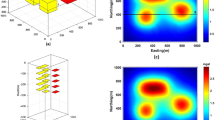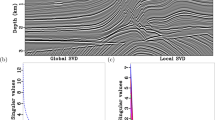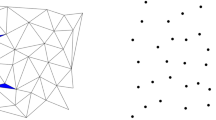Abstract
Continuous representations are fundamental for modeling sampled data and performing computations and numerical simulations directly on the model or its elements. To effectively and efficiently address the approximation of point clouds, we propose the weighted quasi-interpolant spline approximation method (wQISA). We provide global and local bounds of the method and discuss how it still preserves the shape properties of the classical quasi-interpolation scheme. This approach is particularly useful when the data noise can be represented as a probabilistic distribution: from the point of view of non-parametric regression, the wQISA estimator is robust to random perturbations, such as noise and outliers. Finally, we show the effectiveness of the method with several numerical simulations on real data, including curve fitting on images, surface approximation, and simulation of rainfall precipitations.









Similar content being viewed by others
References
Amir, A., Levin, D.: Quasi-interpolation and outliers removal. Numerical Algorithms 78(3), 805–825 (2018)
Anile, A.M., Falcidieno, B., Gallo, G., Spagnuolo, M., Spinello, S.: Modeling uncertain data with fuzzy B-splines. Fuzzy Set. Syst. 113(3), 397–410 (2000)
Beatson, R., Powell, M.: Univariate multiquadric approximation: quasi-interpolation to scattered data. Constr. Approx. 8, 275–288 (1992)
Boffi, D., Brezzi, F., Fortin, M.: Mixed finite element methods and applications, Springer series in computational mathematics, vol. 44. Springer (2013)
de Boor, C., Fix, G.J.: Spline approximation by quasi-interpolants. Journal of Approximation Theory 8(1), 19–45 (1973)
Bracco, C., Giannelli, C., Sestini, A.: Adaptive scattered data fitting by extension of local approximations to hierarchical splines. Computer Aided Geometric Design 52-53, 90 –105 (2017)
Bracco, C., Lyche, T., Manni, C., Roman, F., Speleers, H.: Generalized spline spaces over T-meshes: dimension formula and locally refined generalized B-splines. Appl. Math. Comput. 272, 187–198 (2016)
Briand, T., Monasse, P.: Theory and practice of image B-spline interpolation. Image Processing On Line 8, 99–141 (2018)
Buffa, A., Sangalli, G.: Isogeometric Analysis: a New Paradigm in the Numerical Approximation of PDEs, 2nd edn. Springer, New York (2012)
Buhmann, M.D.: On quasi-interpolation with radial basis functions. Journal of Approximation Theory 72(1), 103–130 (1993)
Buhmann, M.D., Dai, F.: Pointwise approximation with quasi-interpolation by radial basis functions. Journal of Approximation Theory 192, 156–192 (2015)
Canny, J.: A computational approach to edge detection. IEEE Trans. Pattern Anal. Mach. Intell. 8(6), 679–698 (1986)
Cao, L.: Data science: a comprehensive overview. ACM Computing Surveys 50(3), 43:1–43:42 (2017)
Carr, J.C., Beatson, R.K., Cherrie, J.B., Mitchell, T.J., Fright, W.R., McCallum, B.C., Evans, T.R.: Reconstruction and representation of 3D objects with radial basis functions. In: Proceedings of SIGGRAPH ’01, pp 67–76. ACM, New York (2001)
Cheng, F., Barsky, B.A.: Interproximation: interpolation and approximation using cubic spline curves. Comput. Aided Des. 23(10), 700–706 (1991)
Cohen, E., Lyche, T., Riesenfeld, R.R.: Discrete B-splines and subdivision techniques in computer-aided design and computer graphics. Computer Graphics & Image Processing 14(2), 87–111 (1980)
Deza, M.M., Deza, E.: Encyclopedia of Distances. Springer, Berlin (2009)
Dokken, T., Lyche, T., Pettersen, K.F.: Polynomial splines over locally refined box-partitions. Computer Aided Geometric Design 30(3), 331–356 (2013)
Farin, G.: Curves and Surfaces for Computer Aided Geometric Design (3rd Ed.): a Practical Guide. Academic Press Professional, Inc., San Diego (1993)
Forsey, D.R., Bartels, R.H.: Hierarchical B-spline refinement. ACM SIGGRAPH Computer Graphics: 205–212 (1988)
Friedman, J.H., Bentley, J.L., Finkel, R.A.: An algorithm for finding best matches in logarithmic expected time. ACM Transaction on Mathematical Software 3(3), 209–226 (1977)
Gao, W., Fasshauer, G.E., Sun, X., Zhou, X.: Optimality and regularization properties of quasi-interpolation: both deterministic and stochastic perspectives. SIAM Journal on numerical analysis 58(4), 2059–2078 (2020)
Gao, W., Wu, Z.: Approximation orders and shape preserving properties of the multiquadric trigonometric B-spline quasi-interpolant. Computers & Mathematics with Applications 69(7), 696–707 (2015)
Gao, W., Wu, Z., Sun, X., Zhou, X.: Multivariate Monte Carlo approximation based on scattered data. SIAM Journal on Scientific Computing 42(4), A2262–A2280 (2020)
Gao, W., Zhang, R.: Multiquadric trigonometric spline quasi-interpolation for numerical differentiation of noisy data: a stochastic perspective. Numerical Algorithms 77(1), 243–259 (2018)
Giannelli, C., Jüttler, B., Kleiss, S.K., Mantzaflaris, A., Simeon, B., Špeh, J.: THB-splines: an effective mathematical technology for adaptive refinement in geometric design and isogeometric analysis. Comput. Methods Appl. Mech. Eng. 299, 337–365 (2016)
Goodman, T.N.T.: Shape preserving representations. Mathematical Methods in Computer Aided Geometric Design, 333–351 (1989)
Gregory, J.A.: Shape preserving spline interpolation. Computer Aided Design 18(1), 53–57 (1986)
Hastie, T., Tibshirani, R., Friedman, J.: The Elements of Statistical Learning. Data Mining, Inference, and Prediction, 2nd edn. Springer, Berlin (2009)
Hughes, T.J.R., Cottrell, J.A., Bazilevs, Y.: Isogeometric analysis: CAD, finite elements, NURBS, exact geometry and mesh refinement. Comput. Methods Appl. Mech. Eng. 194(39), 4135–4195 (2005)
iQmulus: A High-volume Fusion and Analysis Platform for Geospatial Point Clouds, Coverages and Volumetric Data Sets. http://iqmulus.eu/ (2012–2016)
Jiang, Z.W., Wang, R.H., Zhu, C.G., Xu, M.: High accuracy multiquadric quasi-interpolation. Appl. Math. Model. 35(5), 2185–2195 (2011)
Johannessen, K.A., Kvamsdal, T., Dokken, T.: Isogeometric analysis using LR B-splines. Comput. Methods Appl. Mech. Eng. 269, 471–514 (2014)
Johannessen, K.A., Remonato, F., Kvamsdal, T.: On the similarities and differences between classical hierarchical, truncated hierarchical and LR B-splines. Comput. Methods Appl. Mech. Eng. 291, 64–101 (2015)
Karageorghis, V., Karageorghis, J.: The Coroplastic Art of Ancient Cyprus. A.G. Leventis Foundation, Nicosia (1991)
Lee, S., Wolberg, G., Shin, S.Y.: Scattered data interpolation with multilevel B-splines. IEEE Trans. Vis. Comput. Graph. 3(3), 228–244 (1997)
Lenarduzzi, L.: Practical selection of neighbourhoods for local regression in the bivariate case. Numerical Algorithms 5(4), 205–213 (1993)
Long, X.Y., Mao, D.L., Jiang, C., Wei, F.Y., Li, G.J.: Unified uncertainty analysis under probabilistic, evidence, fuzzy and interval uncertainties. Comput. Methods Appl. Mech. Eng. 355, 1–26 (2019)
Lyche, T., Mørken, K.: Spline Methods Draft, chap. Tensor Product Spline Surfaces, pp. 149–166. Centre of Mathematics for Applications University of Oslo (2011)
Moscoso Thompson, E., Gerasimos, A., Moustakas, K., Nguyen, E.R., Tran, M., Lejemble, T., Barthe, L., Mellado, N., Romanengo, C., Biasotti, S., Falcidieno, B.: SHREC’19 track: Feature Curve Extraction on Triangle Meshes. In: Biasotti, S., Lavoué, G., Falcidieno, B., Pratikakis, I. (eds.) Eurographics Workshop on 3D Object Retrieval (2019)
Occelli, M., Elguedj, T., Bouabdallah, S., Morançay, L.: LR B-splines implementation in the Altair RadiossTM solver for explicit dynamics isogeometric analysis. Advances in Engineering Software (2019)
Ohtake, Y., Belyaev, A., Alexa, M., Turk, G., Seidel, H.P.: Multi-level partition of unity implicits. ACM Trans. Graph. 22(3), 463–470 (2003)
Patané, G., Cerri, A., Skytt, V., Pittaluga, S., Biasotti, S., Sobrero, D., Dokken, T., Spagnuolo, M.: Comparing methods for the approximation of rainfall fields in environmental applications. ISPRS J. Photogramm. and Remote Sensing 127, 57–72 (2017)
Patrizi, F., Manni, C., Pelosi, F., Speleers, H.: Adaptive refinement with locally linearly independent LR B-splines: theory and applications. Comput. Methods Appl. Mech. Eng. 369, 113230 (2020)
Piegl, L., Tiller, W.: The NURBS Book. Springer, New York (1996)
Raffo, A., Biasotti, S.: Data-driven quasi-interpolant spline surfaces for point cloud approximation. Computers & Graphics 89, 144–155 (2020)
Sablonnière, P.: Recent progress on univariate and multivariate polynomial and spline quasi-interpolants. In: Mache, D. H., Szabados, J., de Bruin, M. G. (eds.) Trends and Applications in Constructive Approximation, pp 229–245. Basel, Birkhäuser (2005)
Schumaker, L.L.: Spline Functions: Basis Theory, 3rd edn. Cambridge University Press, Cambridge (2007)
Sederberg, T.W., Zheng, J., Bakenov, A., Nasri, A.: T-splines and T-NURCCS. ACM Trans. Graph. 22(3), 477–484 (2003)
Sorgente, T., Biasotti, S., Livesu, M., Spagnuolo, M.: Topology-driven shape chartification. Computer Aided Geometric Design 65, 13–28 (2018)
Speleers, H., Manni, C.: Effortless quasi-interpolation in hierarchical spaces. Numer. Math. 132(1), 155–184 (2016)
Taha, A.A., Hanbury, A.: Metrics for evaluating 3D medical image segmentation: analysis, selection, and tool. In: BMC Medical Imaging (2015)
The Shape Repository. http://visionair.ge.imati.cnr.it/ontologies/shapes/ (2011–2015)
Torrente, M.L., Biasotti, S., Falcidieno, B.: Recognition of feature curves on 3D shapes using an algebraic approach to Hough transforms. Pattern Recogn. 73, 111–130 (2018)
Wu, Z., Schaback, R.: Shape preserving properties and convergence of univariate multiquadric quasi-interpolation. Acta Mathematicae Applicatae Sinica 10, 441–446 (1994)
Acknowledgments
The authors thank Dr. Bianca Falcidieno and Dr. Michela Spagnuolo for the fruitful discussions; Dr. Oliver J. D. Barrowclough, and Dr. Tor Dokken for their concern as supervisors; Dr. Georg Muntingh for his constructive suggestions that have enhanced the mathematical structure and the exposition of the article; the reviewers, for their positive suggestions, which have significantly contributed to extend the references.
Funding
This project has received funding from the European Union’s Horizon 2020 research and innovation program under the Marie Skłodowska-Curie grant agreement no. 675789. This work has been co-financed by the “POR FSE, Programma Operativo Regione Liguria” 2014-2020, no. RLOF18ASSRIC/68/1, and partially developed in the CNR-IMATI activities DIT.AD021.080.001 and DIT.AD009.091.001.
Author information
Authors and Affiliations
Corresponding authors
Additional information
Publisher’s note
Springer Nature remains neutral with regard to jurisdictional claims in published maps and institutional affiliations.
Appendix A. Univariate case
Appendix A. Univariate case
We will suppose—up to a rotation—that the point cloud \(\mathcal {P}\) can be locally represented by a function of the form \(f:[a,b]\subset \mathbb {R}\to \mathbb {R}\).
Definition 7
Let \(\mathcal {P}\subset \mathbb {R}^{2}\) be a point cloud, \(p\in \mathbb {N}^{\ast }\) and x = [x1,…,xn+p+ 1] a (p + 1)-regular (global) knot vector with fixed boundary knots xp+ 1 = a and xn+ 1 = b. The weighted quasi-interpolant spline approximation of degree p to the point cloud \(\mathcal {P}\) over the knot vector x is defined by
where ξ(i) := (xi + … + xi+p)/p are the knot averages and
are the control points estimators of weight functions \(w_{t}:\mathbb {R}\to [0,+\infty )\).
1.1 A.1 Properties
1.1.1 A.1.1 Global and local bounds
Proposition 2 (Global bounds)
Let \(\mathcal {P}\subset \mathbb {R}^{2}\) be a point cloud. Given \(y_{\min \limits }, y_{\max \limits }\in \mathbb {R}\) that satisfy
then the weighted quasi-interpolant spline approximation to \(\mathcal {P}\) from some spline space \(\mathbb {S}_{p,\mathbf {x}}\) and some weight function w has the same bounds
Proof
From the partition of unity property of a B-spline basis, it follows that

where the inequalities  and
and  are a direct consequence of defining \(\hat {y}_{w}\) by means of a convex combination. □
are a direct consequence of defining \(\hat {y}_{w}\) by means of a convex combination. □
The bounds of Proposition 2 can potentially lead to local bounds. We discuss this situation in Corollary 2.
Corollary 2 (Local bounds)
Let \(\mathcal {P}\subset \mathbb {R}^{2}\) be a point cloud. If x ∈ [xμ,xμ+ 1) for some μ in the range p + 1 ≤ μ ≤ n, then
for some α(μ),β(μ) which belong to [ymin,ymax].
Proof
By using the property of local support for B-splines, it follows that
over [xμ,xμ+ 1). Thus, we can re-write the chain of inequalities (22) as

where
□
Notice that the set of points which are effectively used to compute the approximation, i.e.,
may be a proper subset of \(\mathcal {P}\).
1.1.2 A.1.2 Preservation of monotonicity
Definition 8 (w-monotonicity)
Let \(w_{t}:\mathbb {R}\to [0,+\infty )\) be a family of weight functions, where \(t\in \mathbb {R}\). A point cloud \(\mathcal {P}\subset \mathbb {R}^{2}\) is said to be w-increasing if for all x1 ≤ x2, \(\hat {y}_{w}(x_{1})\le \hat {y}_{w}(x_{2})\). \(\mathcal {P}\) is said to be w-decreasing if for all x1 ≤ x2, \(\hat {y}_{w}(x_{1})\ge \hat {y}_{w}(x_{2})\).
The key ingredient to prove the preservation of monotonicity (Fig. 10) through our method is the following lemma.
Lemma 2
Let \(p\in \mathbb {N}^{\ast }\) and x = [x1,…,xn+p+ 1] be a (p + 1)-regular (global) knot vector with fixed boundary knots xp+ 1 = a and xn+ 1 = b. In addition, let \(f={\sum }_{i=1}^{n}c_{i}B[\mathbf {x}^{(i)}]\in \mathbb {S}_{p,\mathbf {x}}\). If the sequence of coefficients \(\{c_{i}\}_{i=1}^{n}\) is increasing (decreasing) then f is increasing (decreasing).
Proof
The Lemma is proven in [39], pp. 114–115. □
Proposition 3
Let \(\mathcal {P}\subset \mathbb {R}^{2}\) be a point cloud, \(p\in \mathbb {N}^{\ast }\) and x = [x1,…,xn+p+ 1] be a (p + 1)-regular (global) knot vector with fixed boundary knots xp+ 1 = a and xn+ 1 = b. If \(\mathcal {P}\) is w-increasing (decreasing) then fw is also increasing (decreasing).
Proof
By definition of w-increasing (decreasing) point cloud, the sequence of control points \(\{\hat {y}_{w}(\xi ^{(i)})\}_{i=1}^{n}\) is increasing (decreasing). By Lemma 2, this is sufficient to conclude that fw is increasing (decreasing). □
1.1.3 A.1.3 Preservation of convexity
Definition 9 (w-convexity)
Let \(w_{t}:\mathbb {R}\to [0,+\infty )\) be a family of weight functions, where \(t\in \mathbb {R}\). A point cloud \(\mathcal {P}\subset \mathbb {R}^{2}\) is said to be w-convex if for all x1 ≤ x2 and for any λ ∈ [0, 1],
\(\mathcal {P}\) is said to be w-concave if \(\mathcal {P}_{-}:=\{(x,-y) | (x,y)\in \mathcal {P}\}\) is w-convex.
The preservation of convexity (Fig.11) is a consequence of the following lemma.
Lemma 3
Let \(p\in \mathbb {N}^{\ast }\) and x = [x1,…,xn+p+ 1] be a (p + 1)-regular (global) knot vector with fixed boundary knots xp+ 1 = a and xn+ 1 = b. Lastly, let \(f={\sum }_{i=1}^{n}c_{i}B[\mathbf {x}^{(i)}]\in \mathbb {S}_{p,\mathbf {x}}\). Define Δci by
for i = 2,…,n. Then, f is convex on [xp+ 1,xn+ 1] if it is continuous and if the sequence \(\{\Delta c_{i}\}_{i=2}^{n}\) is increasing.
Proof
See [39], p. 118. □
Proposition 4
Let \(\mathcal {P}\subset \mathbb {R}^{2}\) be a point cloud, \(p\in \mathbb {N}^{\ast }\) and x = [x1,…,xn+p+ 1] be a (p + 1)-regular (global) knot vector with fixed boundary knots xp+ 1 = a and xn+ 1 = b. If \(\mathcal {P}\) is w-convex (concave) then fw is also convex (concave).
Proof
Let
with xi < xi+p. Since \(\mathcal {P}\) is w-convex then these differences must be increasing and consequently fw is convex by Lemma 3. □
Rights and permissions
About this article
Cite this article
Raffo, A., Biasotti, S. Weighted quasi-interpolant spline approximations: Properties and applications. Numer Algor 87, 819–847 (2021). https://doi.org/10.1007/s11075-020-00989-4
Received:
Accepted:
Published:
Issue Date:
DOI: https://doi.org/10.1007/s11075-020-00989-4






